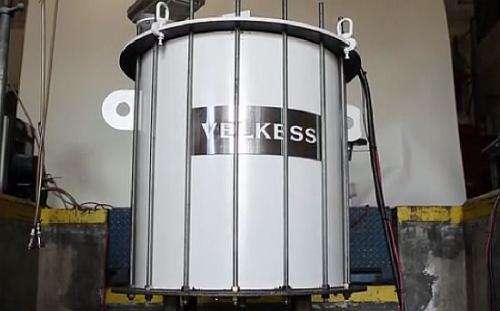April 12, 2013 report
The Velkess Flywheel: A more flexible energy storage technology

(Phys.org) —A new Kickstarter project called Velkess (Very Large Kinetic Energy Storage System) has recently gotten underway to bring an inexpensive flywheel to market. The project is headed by Bill Gray, who has taken a unique approach to flywheel design—a flexible rotor made of "E-glass," a common fiberglass used in everything from sporting goods to shower doors. Rather than use advanced carbon-fiber composites manufactured to exact tolerances, Gray's soft rotor flexes in response to destabilizing forces. It is thereby able to adjust to speed transitions that confound other designs.
With the memory of other flywheel venture failures, like Beacon, fresh in mind, Gray has cast the issues a little differently. While carbon fiber reinforced polymer is 6 to 8 times stronger than E-glass, he notes that E-glass is 10 to 20 times stronger per dollar. Similarly, E-glass will store 10 to 20 times more energy per dollar. The current prototype floats on a magnetic bearing assembly that can handle 2kW of power, and store 0.5 kWh of energy. Their final device will need storage closer to 15kWh to meet the first projected 48-volt off-grid power backup.
This scale up means replacing the 25lb flywheel rotor used for the video footage with a 750lb rotor. Scale-up creates new issues including special production runs for magnets able to support that load, and also equipment to safely handle all that magnetic force floating around. Details of the bearing-motor assembly are still not publicly available. Since the rotor design is essentially cantilevered from the motor in the vertical plane, anything here is possible. For example it appears that the rotor has a low-end speed of 9000 RPM. That would be where it is not even transitioning power. To get to the 15kWh regime, we are probably talking about a max RPM on the order of that of a jet engine.
Jet engine speeds are well above even the fastest comparable electric motor speeds. For example, high-speed spindles for machine tools, that might put out anything approaching say 30kW, would probably max out below 10,000 RPM—and these motors can cost over $50,000. Probably some fancy gearing is involved here, and therefore ample opportunity for unique combinations of bearings to be employed throughout the system.
Where mechanical bearings are to be used, they can have thermal sensors to detect any rise in temperature that would indicate a failure may be about to occur. The possibility for catastrophe due to fracture in one of the silicon nitride bearings can be therefore be greatly reduced. In an off-grid shutdown, the device would dissipate its energy in the form of exhausted hot air. As the rotor slowed over the course of ten hours, this would be a similar flow as a 1500-watt hair dryer might put out.
Gray expects the final units to be comparable in price to lead acid batteries while having a much improved lifetime. Also, the construction materials will be environmentally friendly. The rotor will operate in a vacuum and it is expected that only about 2 percent of its stored power will be lost to friction each day. These numbers make the new flywheel design look like it could be a viable alternative not just to batteries but also to other green schemes like compressed air storage, or pumping water uphill. If the Velkess project can get backing on a scale similar to what these technologies have attracted, flywheels may have finally come of age.
More information:
www.kickstarter.com/projects/1 … kess-energy-storage#
velkess.com/
www.google.com/patents/EP2232680A1
© 2013 Phys.org

















